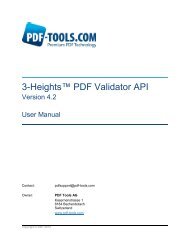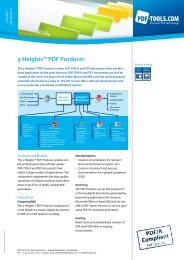Desktop - PDF Tools AG
Desktop - PDF Tools AG
Desktop - PDF Tools AG
You also want an ePaper? Increase the reach of your titles
YUMPU automatically turns print PDFs into web optimized ePapers that Google loves.
3-Heights <strong>PDF</strong> <strong>Desktop</strong> Producer, Version 4.2 Page 43 of 50<br />
July 26, 2013<br />
7 Document Conversion Accuracy<br />
The <strong>PDF</strong> Producer has been designed to map the printed appearance of the source<br />
document’s pages into an accurate representation in the <strong>PDF</strong> document. This is one of<br />
the reasons why the <strong>PDF</strong> Producer has been implemented without any dependencies to<br />
existing drivers such as the PostScript driver with its known limitations.<br />
However, there are inherent limitations regarding conversion accuracy which are given<br />
by the Windows spooler architecture, in particular the limitations of the GDI and EMF<br />
interface specification.<br />
Furthermore, some settings influence the conversion accuracy.<br />
7.1 Known Issues of the GDI and EMF Spooler System<br />
Direct Printing<br />
vs. Spooling<br />
Direct printing produces the <strong>PDF</strong> output file synchronously during<br />
the print operation which means that the <strong>PDF</strong> file creation finishes<br />
at the same time as the print operation completes. Spooling<br />
produces an intermediate EMF spool file which is converted<br />
asynchronously meaning that the print operation terminates earlier<br />
than the <strong>PDF</strong> file creation.<br />
Direct printing produces more accurate results than spooling in<br />
general. The following operations are not supported by GDI when<br />
choosing spooling:<br />
Pattern brushes to stroke lines<br />
Certain types of bitmap operations<br />
7.2 Conversion Accuracy Settings<br />
Back Buffer<br />
Down-sample<br />
Images<br />
Usually a printer driver (e.g. the PostScript driver) assumes that<br />
the target page is a paper sheet. Thus, complex graphics features<br />
such as transparency blending is not supported. In general, all<br />
raster operations which require “reading” from the target surface<br />
are not supported.<br />
Enabling the back buffer performs all complex raster operations in<br />
memory before sending the result to the target surface, in this<br />
case the <strong>PDF</strong> page. If simple raster operations are used which do<br />
not require a back buffer, it is not used.<br />
Enabling the back buffer increases conversion accuracy but makes<br />
the resulting <strong>PDF</strong> file in general bigger.<br />
If the resolution of a raster image is higher than the desired<br />
resolution (see print quality), then the number of samples is<br />
reduced to match the desired resolution.<br />
Down-sampling reduces the quality of the image (usually only<br />
visible when zooming) but reduces the size of the resulting <strong>PDF</strong> file<br />
in general.<br />
<strong>PDF</strong> <strong>Tools</strong> <strong>AG</strong> – Premium <strong>PDF</strong> Technology
















